Walden University PUBH 8450: Survey Protocol for Diabetes Assessment
VerifiedAdded on 2022/09/22
|10
|1259
|18
Homework Assignment
AI Summary
This assignment presents a survey protocol developed by a student to assess the contributing factors behind the high prevalence of diabetes in King County, Washington. The protocol outlines the survey's objectives, which include gathering perspectives on living with diabetes, identifying contributing factors, understanding current treatments, and exploring potential solutions. The rationale for choosing the target population (medium to low demographic status, ages 25-44) is explained, along with the adoption of a quantitative research design. The methodology details the data collection process via an emailed survey, sample size calculation, ethical considerations, and data analysis using SPSS software. The survey questionnaire includes questions on demographics, diabetes status, treatment adherence, ethnicity, physical activity, awareness of resources, and self-care practices. References to relevant literature support the methodological choices. This assignment provides valuable insights into the design and implementation of a community health survey aimed at understanding and addressing diabetes prevalence.
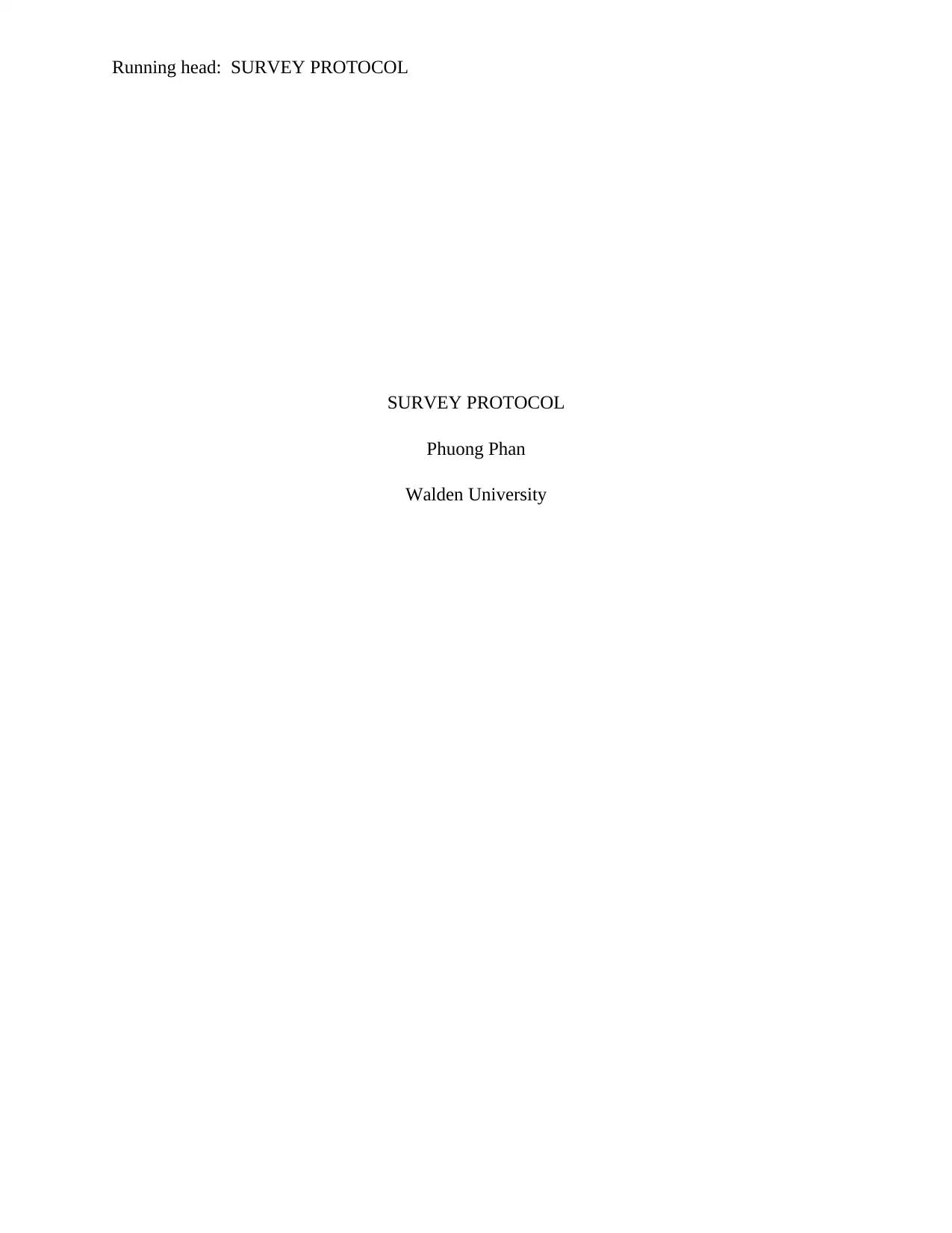
Running head: SURVEY PROTOCOL
SURVEY PROTOCOL
Phuong Phan
Walden University
SURVEY PROTOCOL
Phuong Phan
Walden University
Paraphrase This Document
Need a fresh take? Get an instant paraphrase of this document with our AI Paraphraser
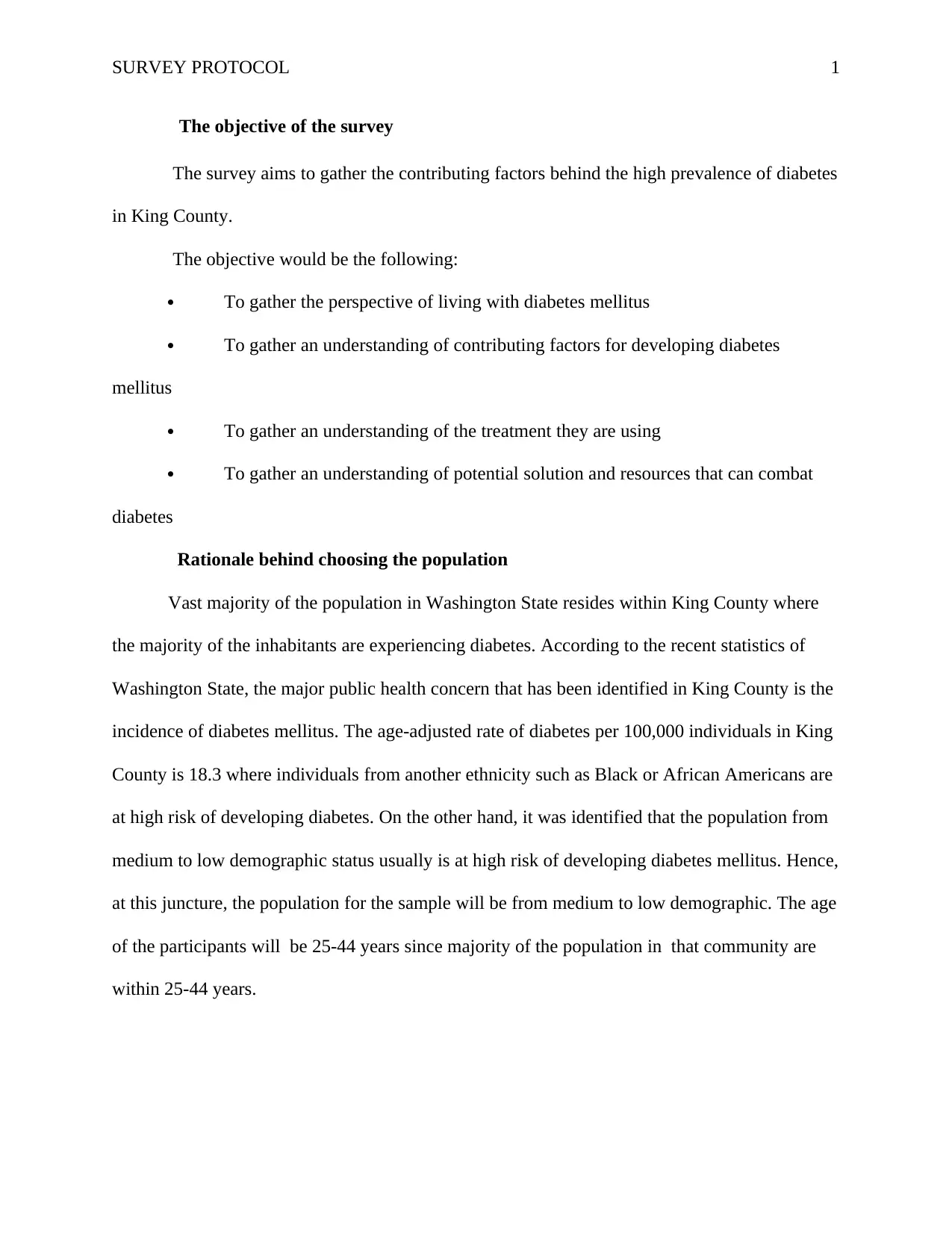
SURVEY PROTOCOL 1
The objective of the survey
The survey aims to gather the contributing factors behind the high prevalence of diabetes
in King County.
The objective would be the following:
To gather the perspective of living with diabetes mellitus
To gather an understanding of contributing factors for developing diabetes
mellitus
To gather an understanding of the treatment they are using
To gather an understanding of potential solution and resources that can combat
diabetes
Rationale behind choosing the population
Vast majority of the population in Washington State resides within King County where
the majority of the inhabitants are experiencing diabetes. According to the recent statistics of
Washington State, the major public health concern that has been identified in King County is the
incidence of diabetes mellitus. The age-adjusted rate of diabetes per 100,000 individuals in King
County is 18.3 where individuals from another ethnicity such as Black or African Americans are
at high risk of developing diabetes. On the other hand, it was identified that the population from
medium to low demographic status usually is at high risk of developing diabetes mellitus. Hence,
at this juncture, the population for the sample will be from medium to low demographic. The age
of the participants will be 25-44 years since majority of the population in that community are
within 25-44 years.
The objective of the survey
The survey aims to gather the contributing factors behind the high prevalence of diabetes
in King County.
The objective would be the following:
To gather the perspective of living with diabetes mellitus
To gather an understanding of contributing factors for developing diabetes
mellitus
To gather an understanding of the treatment they are using
To gather an understanding of potential solution and resources that can combat
diabetes
Rationale behind choosing the population
Vast majority of the population in Washington State resides within King County where
the majority of the inhabitants are experiencing diabetes. According to the recent statistics of
Washington State, the major public health concern that has been identified in King County is the
incidence of diabetes mellitus. The age-adjusted rate of diabetes per 100,000 individuals in King
County is 18.3 where individuals from another ethnicity such as Black or African Americans are
at high risk of developing diabetes. On the other hand, it was identified that the population from
medium to low demographic status usually is at high risk of developing diabetes mellitus. Hence,
at this juncture, the population for the sample will be from medium to low demographic. The age
of the participants will be 25-44 years since majority of the population in that community are
within 25-44 years.
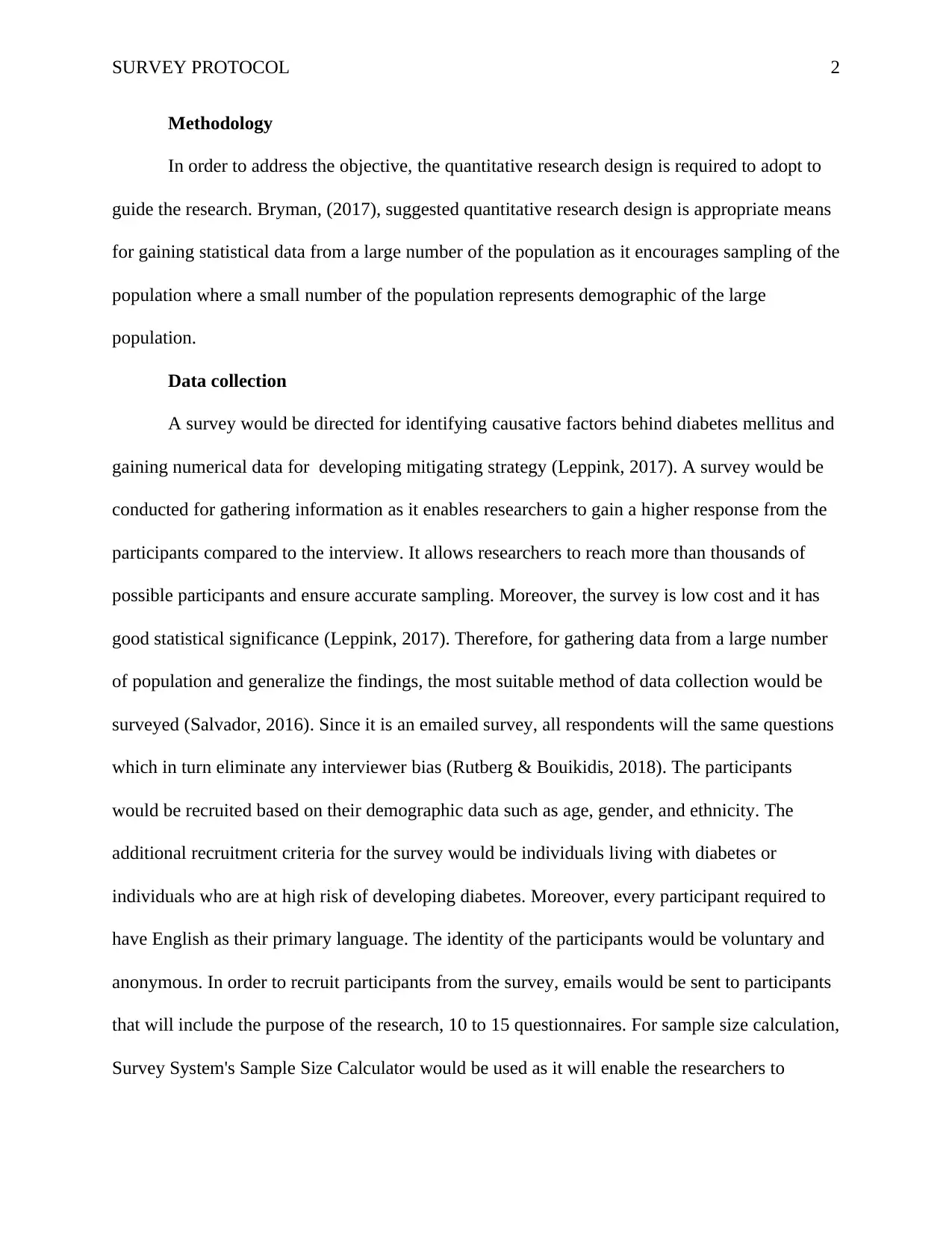
SURVEY PROTOCOL 2
Methodology
In order to address the objective, the quantitative research design is required to adopt to
guide the research. Bryman, (2017), suggested quantitative research design is appropriate means
for gaining statistical data from a large number of the population as it encourages sampling of the
population where a small number of the population represents demographic of the large
population.
Data collection
A survey would be directed for identifying causative factors behind diabetes mellitus and
gaining numerical data for developing mitigating strategy (Leppink, 2017). A survey would be
conducted for gathering information as it enables researchers to gain a higher response from the
participants compared to the interview. It allows researchers to reach more than thousands of
possible participants and ensure accurate sampling. Moreover, the survey is low cost and it has
good statistical significance (Leppink, 2017). Therefore, for gathering data from a large number
of population and generalize the findings, the most suitable method of data collection would be
surveyed (Salvador, 2016). Since it is an emailed survey, all respondents will the same questions
which in turn eliminate any interviewer bias (Rutberg & Bouikidis, 2018). The participants
would be recruited based on their demographic data such as age, gender, and ethnicity. The
additional recruitment criteria for the survey would be individuals living with diabetes or
individuals who are at high risk of developing diabetes. Moreover, every participant required to
have English as their primary language. The identity of the participants would be voluntary and
anonymous. In order to recruit participants from the survey, emails would be sent to participants
that will include the purpose of the research, 10 to 15 questionnaires. For sample size calculation,
Survey System's Sample Size Calculator would be used as it will enable the researchers to
Methodology
In order to address the objective, the quantitative research design is required to adopt to
guide the research. Bryman, (2017), suggested quantitative research design is appropriate means
for gaining statistical data from a large number of the population as it encourages sampling of the
population where a small number of the population represents demographic of the large
population.
Data collection
A survey would be directed for identifying causative factors behind diabetes mellitus and
gaining numerical data for developing mitigating strategy (Leppink, 2017). A survey would be
conducted for gathering information as it enables researchers to gain a higher response from the
participants compared to the interview. It allows researchers to reach more than thousands of
possible participants and ensure accurate sampling. Moreover, the survey is low cost and it has
good statistical significance (Leppink, 2017). Therefore, for gathering data from a large number
of population and generalize the findings, the most suitable method of data collection would be
surveyed (Salvador, 2016). Since it is an emailed survey, all respondents will the same questions
which in turn eliminate any interviewer bias (Rutberg & Bouikidis, 2018). The participants
would be recruited based on their demographic data such as age, gender, and ethnicity. The
additional recruitment criteria for the survey would be individuals living with diabetes or
individuals who are at high risk of developing diabetes. Moreover, every participant required to
have English as their primary language. The identity of the participants would be voluntary and
anonymous. In order to recruit participants from the survey, emails would be sent to participants
that will include the purpose of the research, 10 to 15 questionnaires. For sample size calculation,
Survey System's Sample Size Calculator would be used as it will enable the researchers to
⊘ This is a preview!⊘
Do you want full access?
Subscribe today to unlock all pages.

Trusted by 1+ million students worldwide
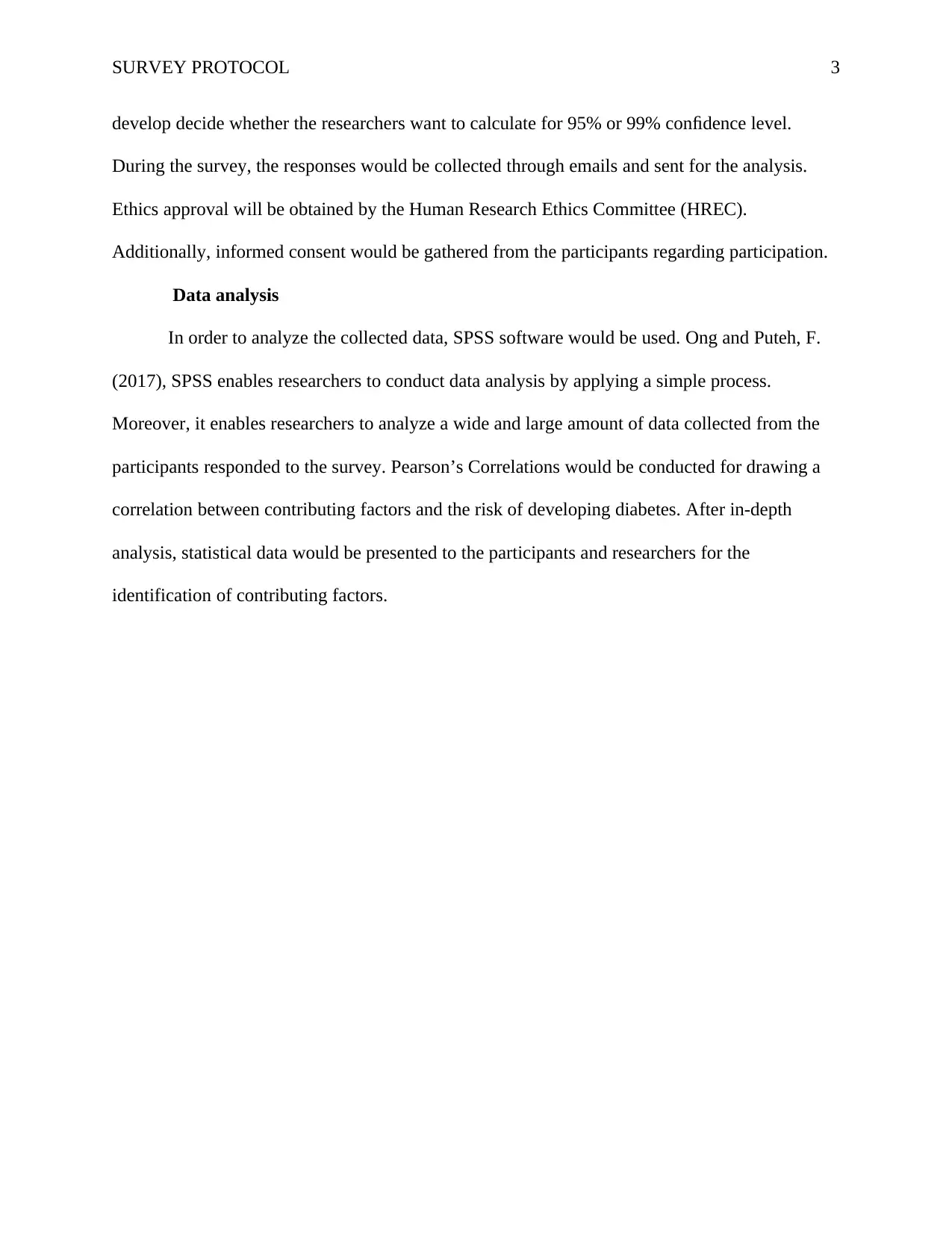
SURVEY PROTOCOL 3
develop decide whether the researchers want to calculate for 95% or 99% confidence level.
During the survey, the responses would be collected through emails and sent for the analysis.
Ethics approval will be obtained by the Human Research Ethics Committee (HREC).
Additionally, informed consent would be gathered from the participants regarding participation.
Data analysis
In order to analyze the collected data, SPSS software would be used. Ong and Puteh, F.
(2017), SPSS enables researchers to conduct data analysis by applying a simple process.
Moreover, it enables researchers to analyze a wide and large amount of data collected from the
participants responded to the survey. Pearson’s Correlations would be conducted for drawing a
correlation between contributing factors and the risk of developing diabetes. After in-depth
analysis, statistical data would be presented to the participants and researchers for the
identification of contributing factors.
develop decide whether the researchers want to calculate for 95% or 99% confidence level.
During the survey, the responses would be collected through emails and sent for the analysis.
Ethics approval will be obtained by the Human Research Ethics Committee (HREC).
Additionally, informed consent would be gathered from the participants regarding participation.
Data analysis
In order to analyze the collected data, SPSS software would be used. Ong and Puteh, F.
(2017), SPSS enables researchers to conduct data analysis by applying a simple process.
Moreover, it enables researchers to analyze a wide and large amount of data collected from the
participants responded to the survey. Pearson’s Correlations would be conducted for drawing a
correlation between contributing factors and the risk of developing diabetes. After in-depth
analysis, statistical data would be presented to the participants and researchers for the
identification of contributing factors.
Paraphrase This Document
Need a fresh take? Get an instant paraphrase of this document with our AI Paraphraser
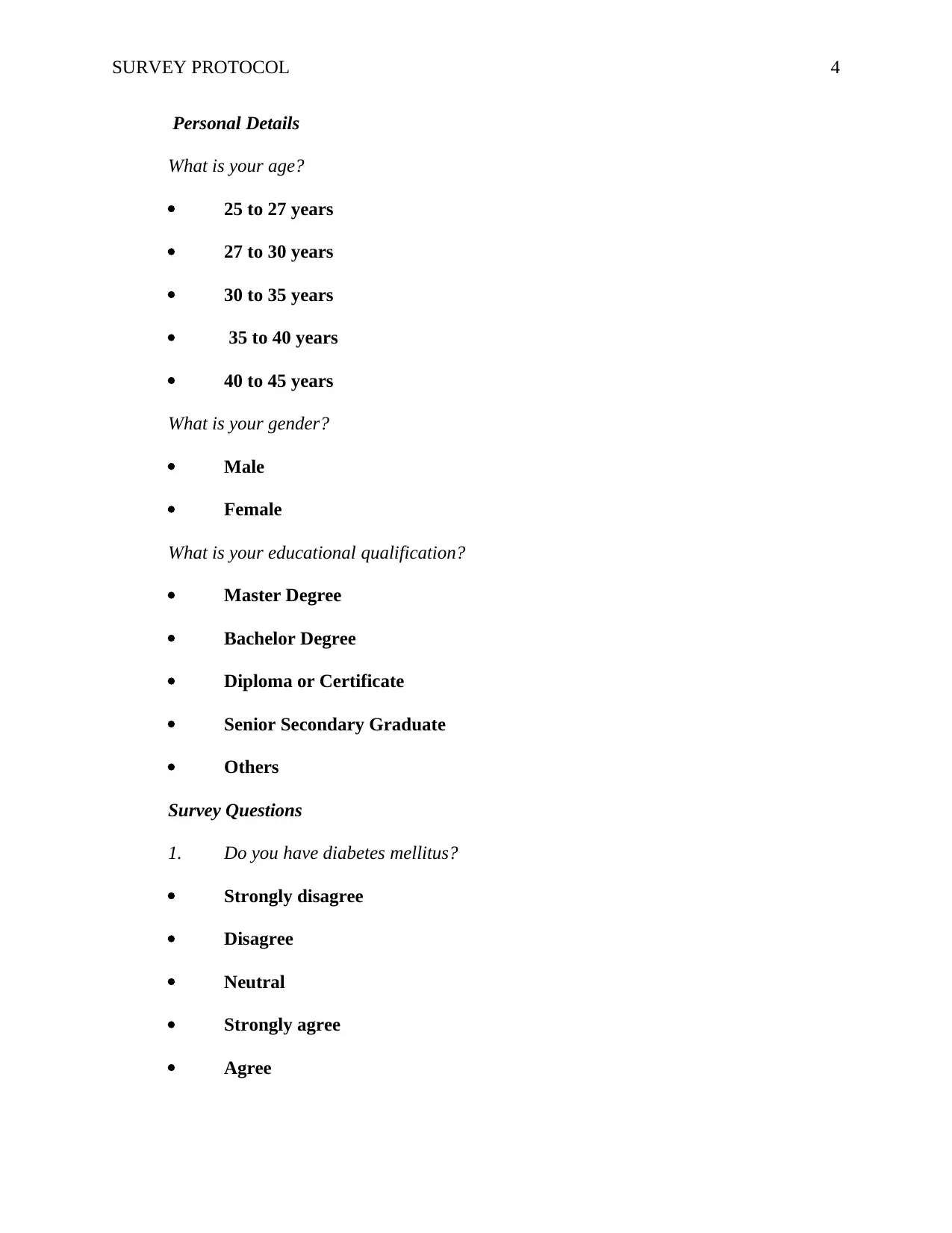
SURVEY PROTOCOL 4
Personal Details
What is your age?
25 to 27 years
27 to 30 years
30 to 35 years
35 to 40 years
40 to 45 years
What is your gender?
Male
Female
What is your educational qualification?
Master Degree
Bachelor Degree
Diploma or Certificate
Senior Secondary Graduate
Others
Survey Questions
1. Do you have diabetes mellitus?
Strongly disagree
Disagree
Neutral
Strongly agree
Agree
Personal Details
What is your age?
25 to 27 years
27 to 30 years
30 to 35 years
35 to 40 years
40 to 45 years
What is your gender?
Male
Female
What is your educational qualification?
Master Degree
Bachelor Degree
Diploma or Certificate
Senior Secondary Graduate
Others
Survey Questions
1. Do you have diabetes mellitus?
Strongly disagree
Disagree
Neutral
Strongly agree
Agree
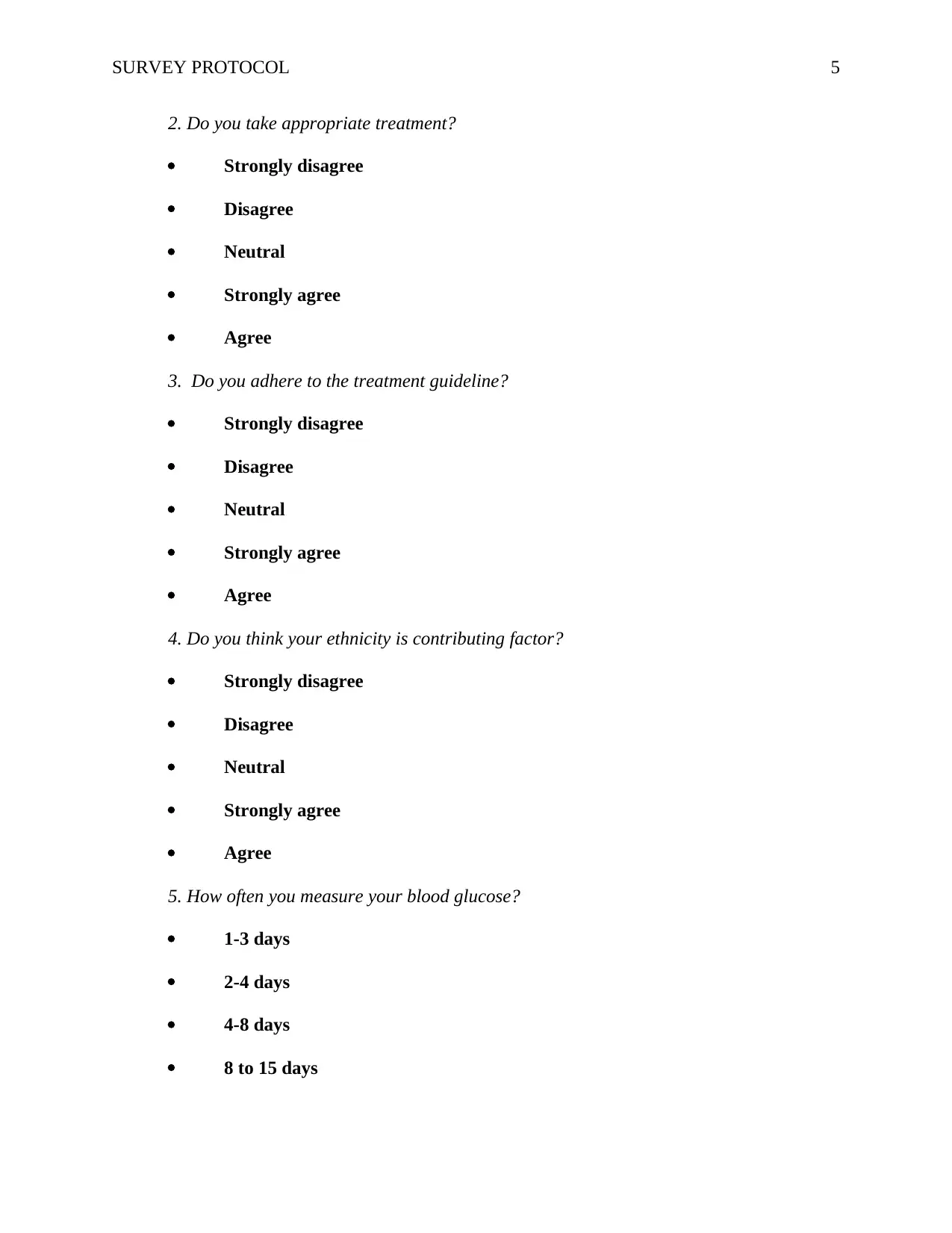
SURVEY PROTOCOL 5
2. Do you take appropriate treatment?
Strongly disagree
Disagree
Neutral
Strongly agree
Agree
3. Do you adhere to the treatment guideline?
Strongly disagree
Disagree
Neutral
Strongly agree
Agree
4. Do you think your ethnicity is contributing factor?
Strongly disagree
Disagree
Neutral
Strongly agree
Agree
5. How often you measure your blood glucose?
1-3 days
2-4 days
4-8 days
8 to 15 days
2. Do you take appropriate treatment?
Strongly disagree
Disagree
Neutral
Strongly agree
Agree
3. Do you adhere to the treatment guideline?
Strongly disagree
Disagree
Neutral
Strongly agree
Agree
4. Do you think your ethnicity is contributing factor?
Strongly disagree
Disagree
Neutral
Strongly agree
Agree
5. How often you measure your blood glucose?
1-3 days
2-4 days
4-8 days
8 to 15 days
⊘ This is a preview!⊘
Do you want full access?
Subscribe today to unlock all pages.

Trusted by 1+ million students worldwide
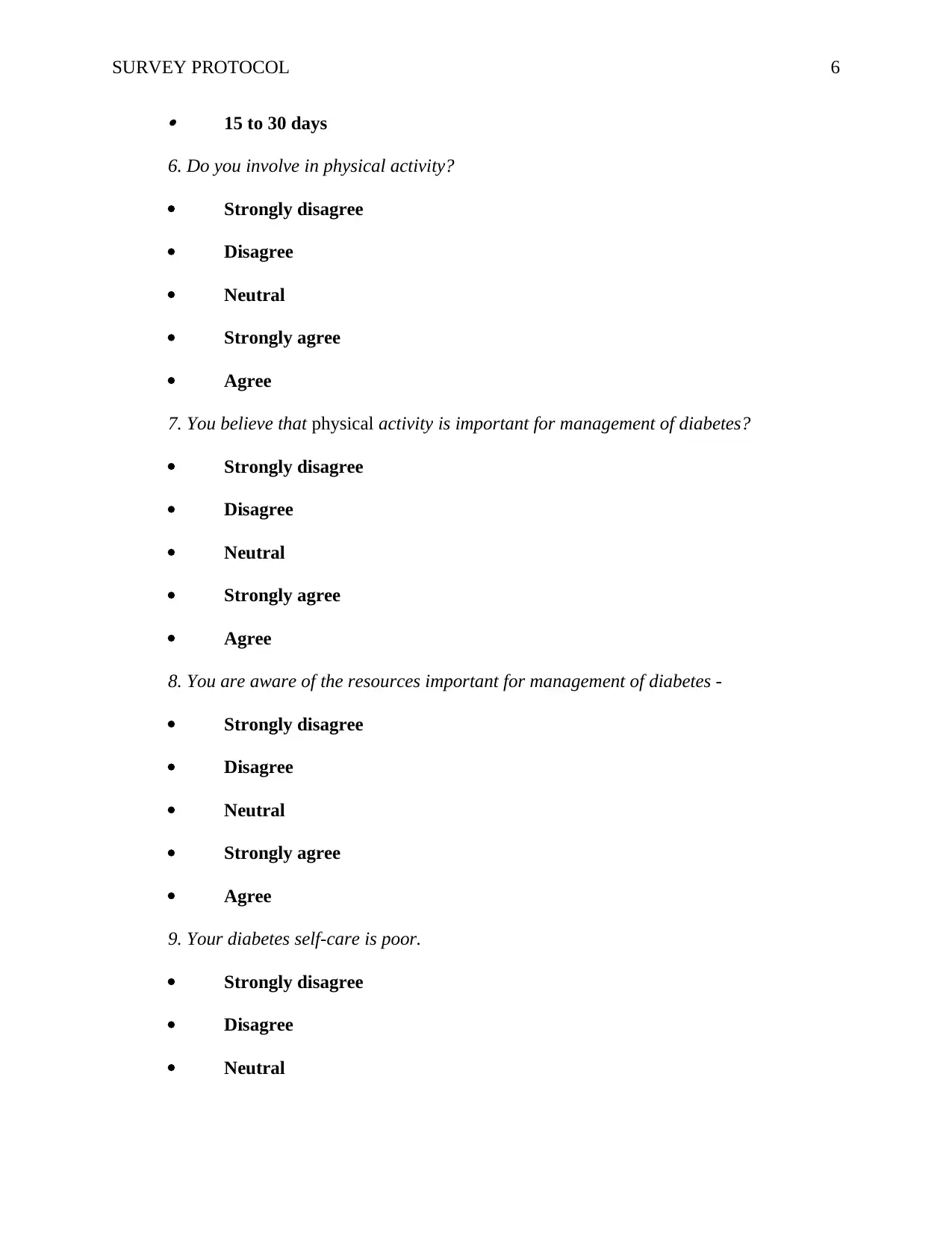
SURVEY PROTOCOL 6
15 to 30 days
6. Do you involve in physical activity?
Strongly disagree
Disagree
Neutral
Strongly agree
Agree
7. You believe that physical activity is important for management of diabetes?
Strongly disagree
Disagree
Neutral
Strongly agree
Agree
8. You are aware of the resources important for management of diabetes -
Strongly disagree
Disagree
Neutral
Strongly agree
Agree
9. Your diabetes self-care is poor.
Strongly disagree
Disagree
Neutral
15 to 30 days
6. Do you involve in physical activity?
Strongly disagree
Disagree
Neutral
Strongly agree
Agree
7. You believe that physical activity is important for management of diabetes?
Strongly disagree
Disagree
Neutral
Strongly agree
Agree
8. You are aware of the resources important for management of diabetes -
Strongly disagree
Disagree
Neutral
Strongly agree
Agree
9. Your diabetes self-care is poor.
Strongly disagree
Disagree
Neutral
Paraphrase This Document
Need a fresh take? Get an instant paraphrase of this document with our AI Paraphraser
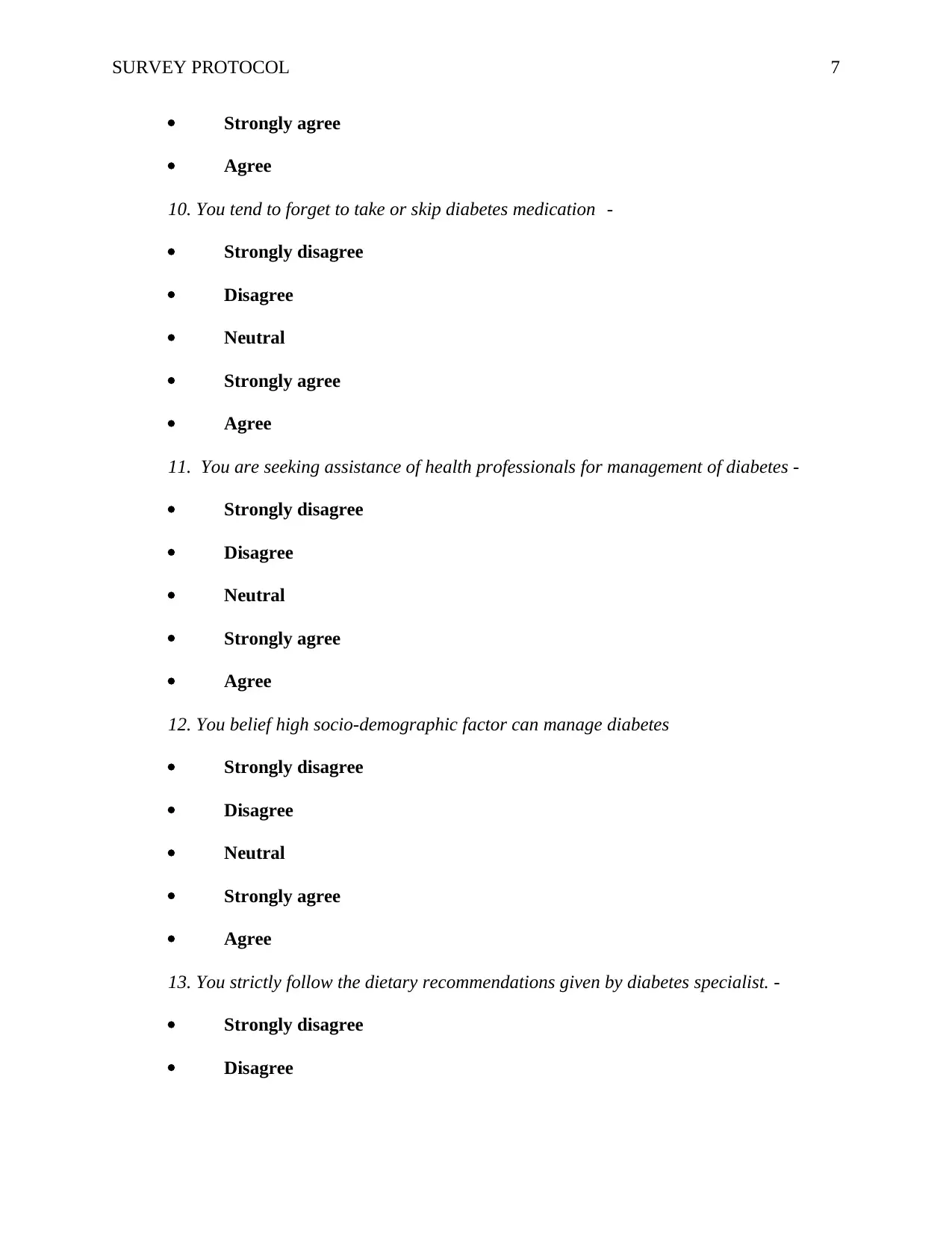
SURVEY PROTOCOL 7
Strongly agree
Agree
10. You tend to forget to take or skip diabetes medication -
Strongly disagree
Disagree
Neutral
Strongly agree
Agree
11. You are seeking assistance of health professionals for management of diabetes -
Strongly disagree
Disagree
Neutral
Strongly agree
Agree
12. You belief high socio-demographic factor can manage diabetes
Strongly disagree
Disagree
Neutral
Strongly agree
Agree
13. You strictly follow the dietary recommendations given by diabetes specialist. -
Strongly disagree
Disagree
Strongly agree
Agree
10. You tend to forget to take or skip diabetes medication -
Strongly disagree
Disagree
Neutral
Strongly agree
Agree
11. You are seeking assistance of health professionals for management of diabetes -
Strongly disagree
Disagree
Neutral
Strongly agree
Agree
12. You belief high socio-demographic factor can manage diabetes
Strongly disagree
Disagree
Neutral
Strongly agree
Agree
13. You strictly follow the dietary recommendations given by diabetes specialist. -
Strongly disagree
Disagree
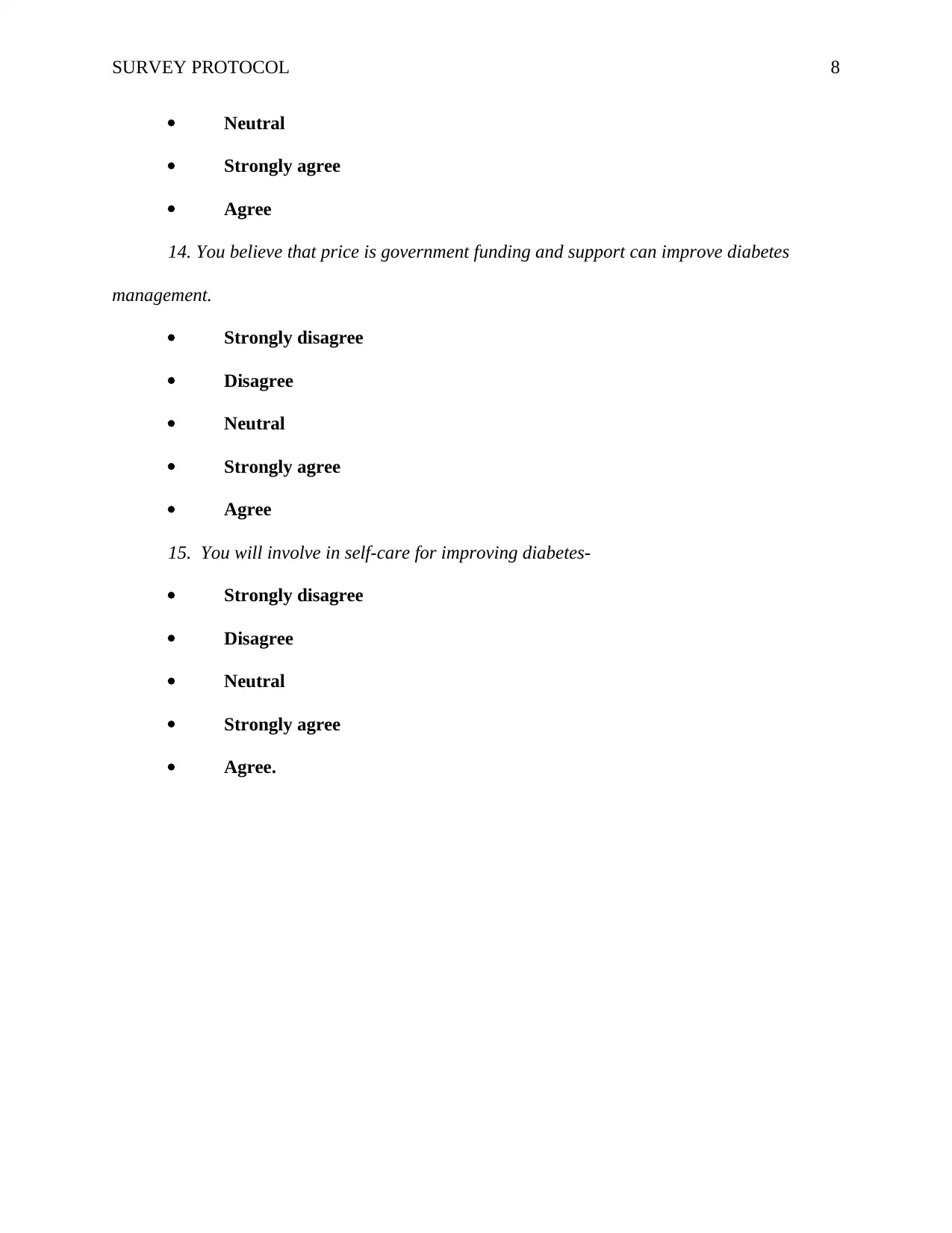
SURVEY PROTOCOL 8
Neutral
Strongly agree
Agree
14. You believe that price is government funding and support can improve diabetes
management.
Strongly disagree
Disagree
Neutral
Strongly agree
Agree
15. You will involve in self-care for improving diabetes-
Strongly disagree
Disagree
Neutral
Strongly agree
Agree.
Neutral
Strongly agree
Agree
14. You believe that price is government funding and support can improve diabetes
management.
Strongly disagree
Disagree
Neutral
Strongly agree
Agree
15. You will involve in self-care for improving diabetes-
Strongly disagree
Disagree
Neutral
Strongly agree
Agree.
⊘ This is a preview!⊘
Do you want full access?
Subscribe today to unlock all pages.

Trusted by 1+ million students worldwide
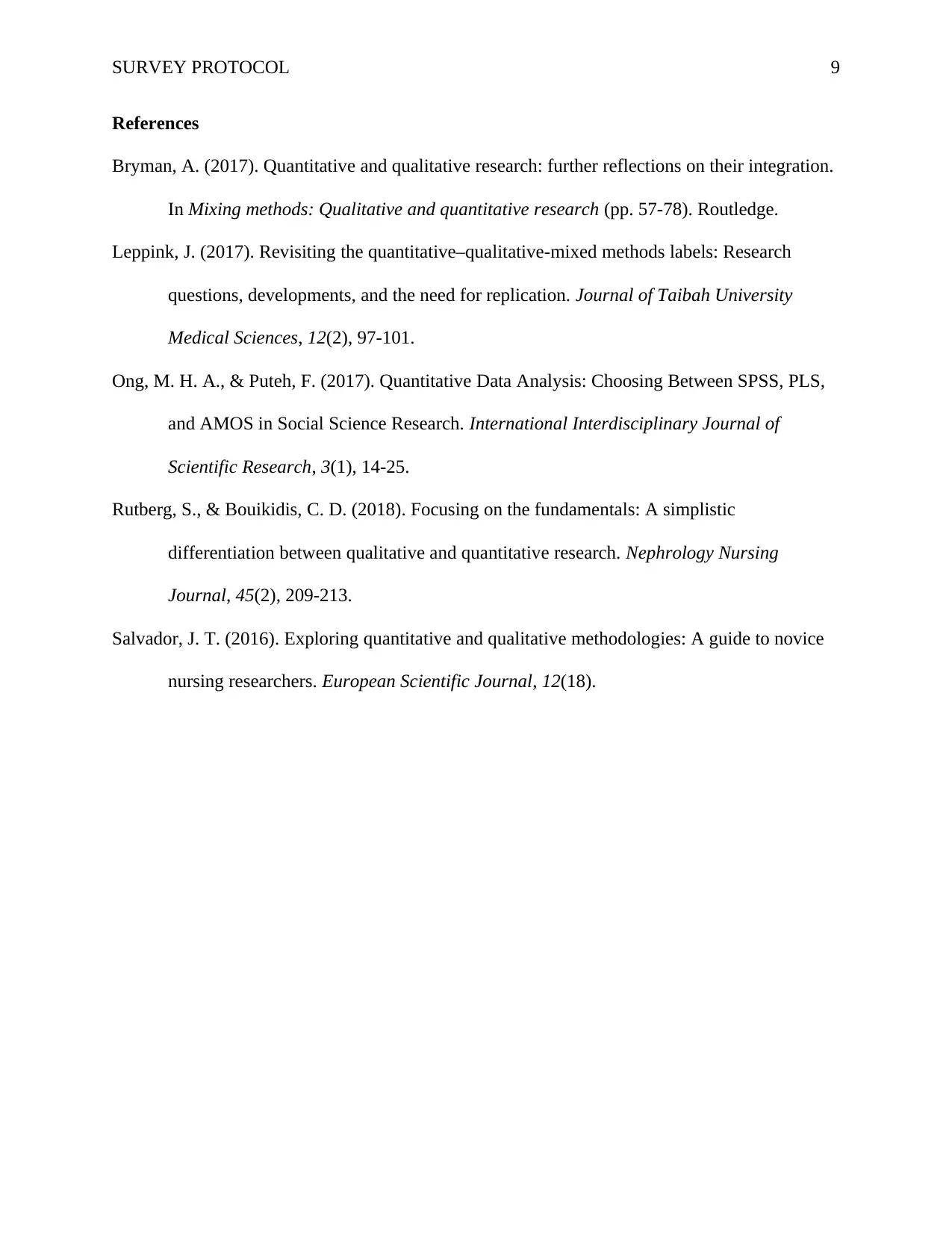
SURVEY PROTOCOL 9
References
Bryman, A. (2017). Quantitative and qualitative research: further reflections on their integration.
In Mixing methods: Qualitative and quantitative research (pp. 57-78). Routledge.
Leppink, J. (2017). Revisiting the quantitative–qualitative-mixed methods labels: Research
questions, developments, and the need for replication. Journal of Taibah University
Medical Sciences, 12(2), 97-101.
Ong, M. H. A., & Puteh, F. (2017). Quantitative Data Analysis: Choosing Between SPSS, PLS,
and AMOS in Social Science Research. International Interdisciplinary Journal of
Scientific Research, 3(1), 14-25.
Rutberg, S., & Bouikidis, C. D. (2018). Focusing on the fundamentals: A simplistic
differentiation between qualitative and quantitative research. Nephrology Nursing
Journal, 45(2), 209-213.
Salvador, J. T. (2016). Exploring quantitative and qualitative methodologies: A guide to novice
nursing researchers. European Scientific Journal, 12(18).
References
Bryman, A. (2017). Quantitative and qualitative research: further reflections on their integration.
In Mixing methods: Qualitative and quantitative research (pp. 57-78). Routledge.
Leppink, J. (2017). Revisiting the quantitative–qualitative-mixed methods labels: Research
questions, developments, and the need for replication. Journal of Taibah University
Medical Sciences, 12(2), 97-101.
Ong, M. H. A., & Puteh, F. (2017). Quantitative Data Analysis: Choosing Between SPSS, PLS,
and AMOS in Social Science Research. International Interdisciplinary Journal of
Scientific Research, 3(1), 14-25.
Rutberg, S., & Bouikidis, C. D. (2018). Focusing on the fundamentals: A simplistic
differentiation between qualitative and quantitative research. Nephrology Nursing
Journal, 45(2), 209-213.
Salvador, J. T. (2016). Exploring quantitative and qualitative methodologies: A guide to novice
nursing researchers. European Scientific Journal, 12(18).
1 out of 10
Related Documents
Your All-in-One AI-Powered Toolkit for Academic Success.
+13062052269
info@desklib.com
Available 24*7 on WhatsApp / Email
![[object Object]](/_next/static/media/star-bottom.7253800d.svg)
Unlock your academic potential
Copyright © 2020–2025 A2Z Services. All Rights Reserved. Developed and managed by ZUCOL.





